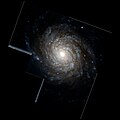| NGC 4030 | |
|---|---|
 | |
| Observation data (J2000 epoch) | |
| Constellation | Virgo |
| Right ascension | 12h 00m 23.643s [2] |
| Declination | –01° 05′ 59.87″ [2] |
| Heliocentric radial velocity | 1,465 [3] km/s |
| Distance | 63.6 ± 4.9 Mly (19.5 ± 1.5 Mpc) [3] |
| Apparent magnitude (V) | 10.6 [4] |
| Characteristics | |
| Type | SA(s)bc [3] |
| Apparent size (V) | 3′.8 × 2′.9 [4] |
| Other designations | |
| PGC 37845, UGC 6993 [3] | |
NGC 4030 is a grand design spiral galaxy [5] located about 64 [3] million light years away in the constellation Virgo. It is a member of the NGC 4030 Group of galaxies, which is a member of the Virgo II Groups, a series of galaxies and galaxy clusters strung out from the southern edge of the Virgo Supercluster. [6] With an apparent visual magnitude of 10.6, it is visible with a small telescope as a 3 arc minute wide feature about 4.75° to the southeast of the star Beta Virginis. [4] It is inclined by an angle of 47.1° [3] to the line of sight from the Earth and is receding at a velocity of 1,465 km/s. [3]
Contents
The morphological classification of NGC 4030 in the De Vaucouleurs system is SA(s)bc, [3] which indicates a spiral structure (SA) with no bar (s) and moderate to loosely wound arms (bc). [7] The inner part of the galaxy shows a complex structure with multiple spiral arms, which becomes a symmetric, double arm pattern beyond 49″ from the core. [5] The central bulge is relatively young with an estimated age of two billion years, [8] while the nucleus is inactive. [9]
In 2007, a supernova explosion was discovered in the galaxy from images taken on February 19 from the 1 m Swope telescope at Las Campanas Observatory in Chile. Designated SN 2007aa, it was a Type IIP [10] supernova positioned 68″.5 north and 60″.8 east of the galactic nucleus. [11] The progenitor was a red giant star with 8.5–16.5 times the mass of the Sun. [10]

